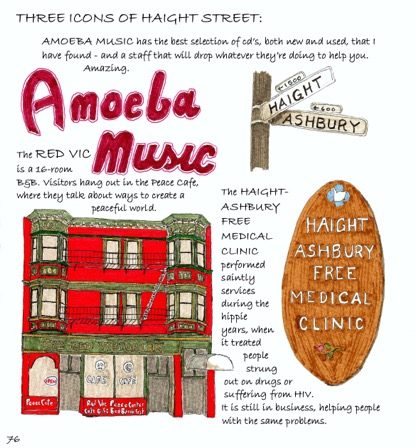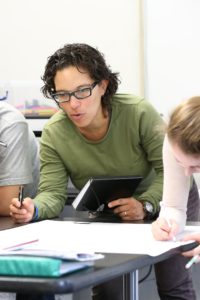
Eleanor Burke looks down at her wrist to see a low pixel screen flashing blue lights. In the midst of one of her many walks, she has just reached 5,000 steps on the day. At age 78, the FitBit provides Burke with encouragement to continue her avid passion for walking. How did that passion develop?
Eleanor Burke, my loving grandmother, has lived in San Francisco all her life. She attended Katherine Delmar Burke School when they had a high school. Her love for the city flourished at a young age, as she started drawing and playing with her friends in the Richmond Neighborhood. During her time at Stanford, she met Bernie Burke, whom she left college to marry in 1958. She raised three children with her husband: Fred Burke, Wendy Burke and Leslie Dicke. Eleanor Burke’s first job was to solder wires together at Hewlett-Packard. Exciting? Not exactly. “That job made me realize how important an education is,” Burke remarks. After returning to San Francisco State to get her masters degree, she worked short stints at Zion Lutheran School and the Drew School before finding her home teaching English at Lick-Wilmerding High School.
As Burke’s coworker Wendy Foster-Leigh explains, “Eleanor was super star English teacher. She was known for her ‘minimal decency’ quizzes and her witty sentences.” Burke gave “minimal decency” quizzes to test basic English usage (i.e. the difference between its and it’s). All students needed to pass the test to pass the class, and rumor has it that she was a tough grader. She is also known for taking groups of high school students to Ashland Oregon to attend the Oregon Shakespeare Festival. At Lick, Burke ran the Paper Tiger for 15 years. Her impassioned work at Lick-Wilmerding has earned her a free pass to all events put on at Lick, including plays and concerts.
Burke’s connection to the city grew stronger as she developed a passion for the San Francisco Giants. She would willingly brave the hypothermic conditions at Candlestick Park to cheer for her beloved Giants. Now, season tickets allow her to enjoy games at the luxurious AT&T Park.

Ultimately, Burke decided to put aside the Shakespeare books; she decided to retire in 1995. Her love for walking took time to develop. First, a Nikon camera was Burke’s focal project. She captured photos anywhere from a sub shop in North Beach to a crowded street in India. After a vacation, it was safe to expect dozens of notecards including drawings of anything from high-rise buildings to a local farmer’s market. When she purchased a motorscooter, she began riding around the city, taking pictures to later sketch. “I liked sketching and I liked San Francisco, so it was a logical way to put the two together,” she commented. What came from these countless experiences was a 139 page book, Sketching San Francisco Neighborhoods, that includes over 485 sketches and personal anecdotes on each page. Her book is sold in bookstores across San Francisco, including Books Inc on Chestnut Street and folio Books on 24th Street.
Four years after she published her first book, Burke began a new project to explore the city she loves. This time, her plans were much more ambitious than riding her scooter around a city which measures seven by seven miles. She wanted to walk every single street in San Francisco. All 2,612 of them (and counting). With an aging body that seemed to slow by the day, Burke embraced the idea of walking as a way to stay healthy by getting exercise. Discussing her fitness goals for the project, Burke reveals that “My average [steps per day] is about 8500 steps, but really it should be 10,000”
On a Sunday afternoon, Burke can be found strolling down Clayton Street during her walk through the Haight-Ashbury. In one hand, Burke has her camera ready, photographing people, shops, houses: anything that she deems sketchable. With her other hand, Burke takes out a leather notebook. Jammed within the notebook sheets is a Google map printout of the streets she is walking today. A smile on her face, she makes a slash through Clayton Street with a highlighter. Taking a look inside her notebook, she reviews her list of must see places: Charles Manson’s house, check. Next up, the Haight Ashbury Free Clinic.

Once she returns home, Burke will upload her photographs to her computer. She meticulously chooses a fraction of these photos to sketch. Then comes the fun part: the sketch. The process repeats itself every time Burke embarks on another adventure. In all, it took her 10 months to mark off 2,612 streets. However, her project is not finished; Burke wants to walk the entirety — all 2,612 streets. While she knows that walking some streets in the Sunset will be painfully monotonous, she maintains, “it’s sort of fun to have a project to do.”
It’s a Sunday in late April, 2016. Although Burke has finished her day’s project, she still desires to walk more. Burke decides to walk along Bush Street. She passes Cottage Row, points out a series of Victorian houses as she approaches Franklin Street. When she crosses Geary Street, she is confronted by the First Universalist Church and Center. She has little interest in the church, however, and she walks right by it. The she announces, “This is a can’t miss.” There stands a stone coffin tucked away in the garden behind the church. In the coffin lies the body of Thomas Starr King, a Unitarian minister and abolitionist who came to California in 1860 to advocate for California to join the Union and become a free state. Lincoln actually credited King for saving the Union because of the persuasive speech King gave in 1862. In fact, King Street in San Francisco is named after him. “It’s one of those things where you walk by the grave a zillion times and don’t notice it…but it has such an interesting story,” Burke says enthusiastically.
 Burke has come to the realization that “walking is the best way to get around the city.” While many perceive walking the streets as dangerous, Burke has run into little trouble on the streets. She has had pleasant interactions with locals, even in some of the notoriously run down neighborhoods. In fact, when asked what neighborhood she particularly enjoyed, Burke cited Bayview Hunters Point without hesitation.
Burke has come to the realization that “walking is the best way to get around the city.” While many perceive walking the streets as dangerous, Burke has run into little trouble on the streets. She has had pleasant interactions with locals, even in some of the notoriously run down neighborhoods. In fact, when asked what neighborhood she particularly enjoyed, Burke cited Bayview Hunters Point without hesitation.
While visiting the Golden Gate Bridge or Alcatraz is definitely worthwhile, it can be even more fun to adhere to the advice of a local. Eleanor Burke’s story goes to show that the knowledge of locals can be far more valuable than the contents of a tourist brochure. Thank you, Grandma, for all you have done.
Walk over Geneva Ave south to Mission Terrace, down Cayuga Ave to Cayuga Park, what Burke calls “a very special place.” In her book, Burke describes the park as “eleven acres of whimsy, wit and magic with painted wooden sculptures…that represent peace, hope and non-denominational spirituality.” After walking through the park, Burke recommends to continue east on Mission Street, where you’ll find a lively community and an abundance of places to get a tasty snack






